Table of contents
- 6 inexpensive full-face helmets in the test Bargain or Risk?
- Bayard SP-51
- Germot GM 306
- LS2 FF352 rookie
- MTR S-5
- Shiro SH-715
- Takai Atlas
- Three other models under 100 euros without a test rating
- Hero katana
- Nexo Basic
- Rocc 300 (model 2015)
- The helmets on the TuV test bench
- This is how MOTORRAD tests
- Wind tunnel tests confirm practical experience
- Interview with TuV test engineer Peter Schaudt
- Hit list of the editors
- MOTORCYCLE final scoring
- Why can they be so cheap at all?
- Test results more pleasing than expected
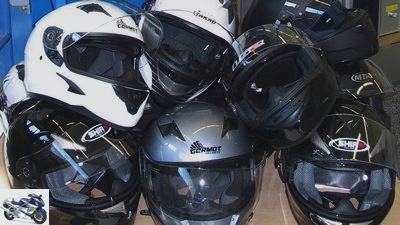
mps photo studio
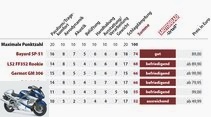
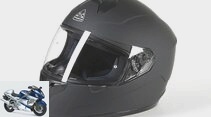
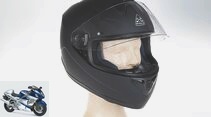
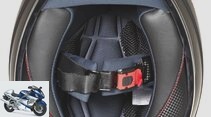
43 pictures
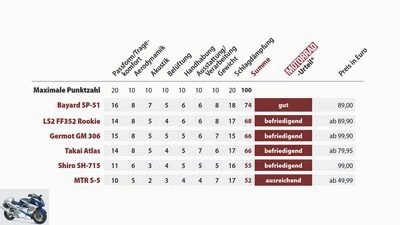
1/43
MOTORCYCLE final scoring
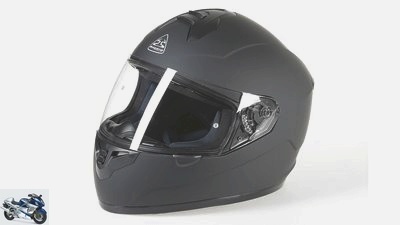
mps photo studio
2/43
Bayard SP-51 (MOTORRAD test winner), MOTORRAD verdict: good

mps photo studio
3/43
Good news when it comes to visor: locking, sealing, field of vision and changing are all right.
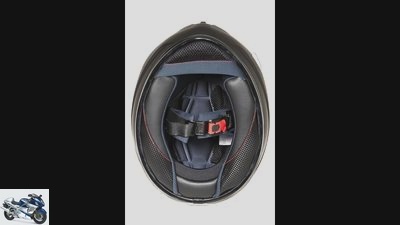
mps photo studio
4/43
The chin strap, however, sits very far back.
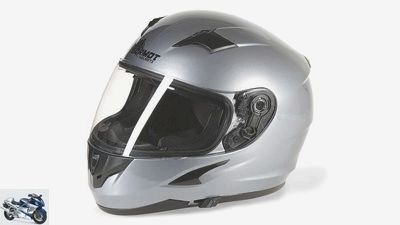
mps photo studio
5/43
Germot GM 306, MOTORRAD judgment: satisfactory
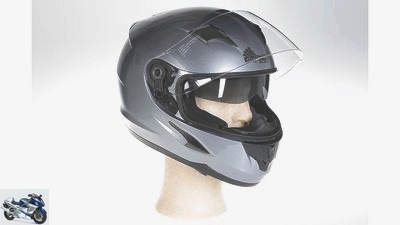
mps photo studio
6/43
A perfectly dimensioned and easy-to-use sun visor is the exception in this price range.
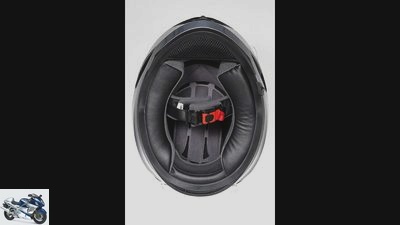
mps photo studio
7/43
Not plush lining.
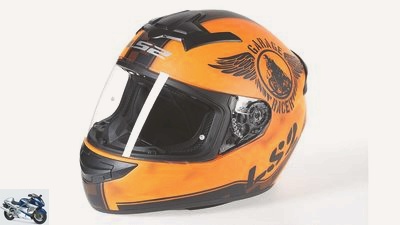
mps photo studio
8/43
LS2 FF352 Rookie, MOTORRAD verdict: satisfactory
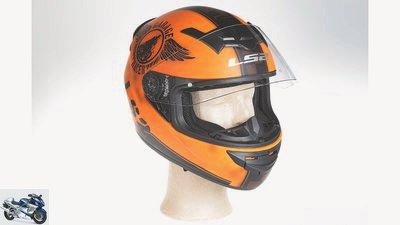
mps photo studio
9/43
Looks chic and is comparatively comfortable to wear.
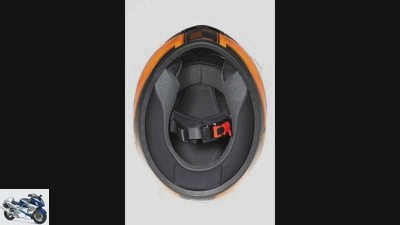
mps photo studio
10/43
Is it a bit more “airy” because of the missing wind deflector on the chin.
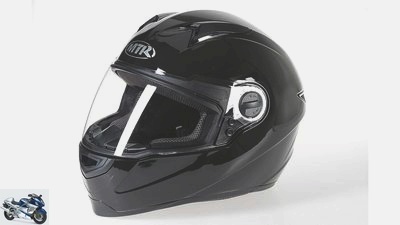
mps photo studio
11/43
MTR S-5, MOTORRAD judgment: sufficient
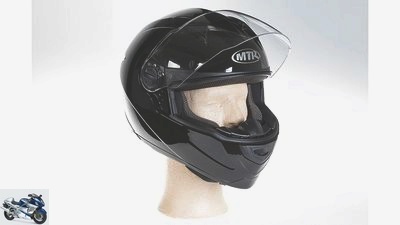
mps photo studio
12/43
Chin strap lock and visor change are – well – a bit “old-fashioned”.
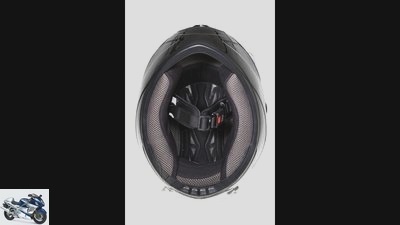
mps photo studio
13/43
And the fit is not one of the great strengths either.
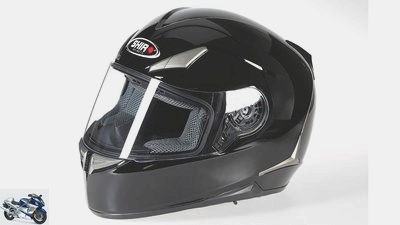
mps photo studio
14/43
Shiro SH-715, MOTORRAD judgment: satisfactory

mps photo studio
15/43
A significantly deeper sun visor would have been nice.
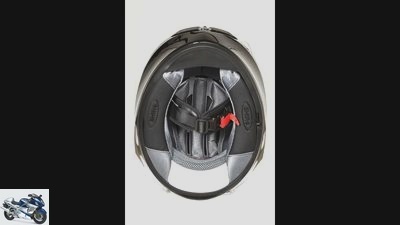
mps photo studio
16/43
The chin strap fits nicely, but the lining is too scratchy for that.

mps photo studio
17/43
Takai Atlas, MOTORRAD judgment: satisfactory

mps photo studio
18/43
The sun visor is absolutely practical, and the fit is also okay.
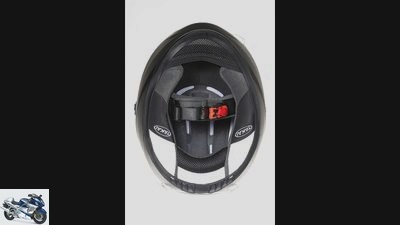
mps photo studio
19/43
Almost a € 200 helmet to the touch.
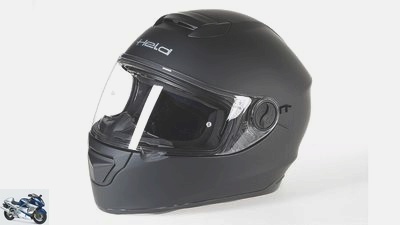
mps photo studio
20/43
Hero katana
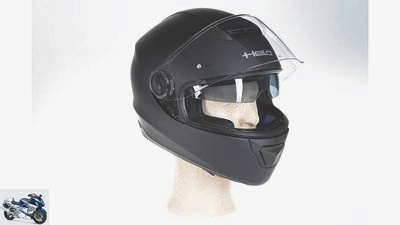
mps photo studio
21/43
Heavyweight with a practical and easy-to-use sun visor…
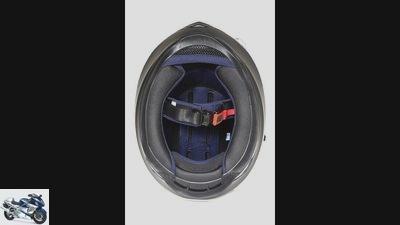
mps photo studio
22/43
…and a relatively low noise level.
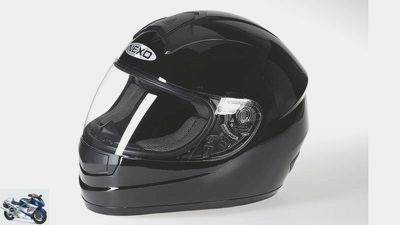
mps photo studio
23/43
Nexo Basic
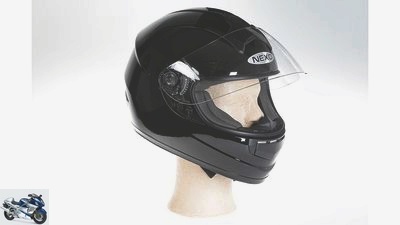
mps photo studio
24/43
An absolutely draft-free visor is the great strength of Nexo.

mps photo studio
25/43
The sweaty lining and the too spongy upholstery are not.
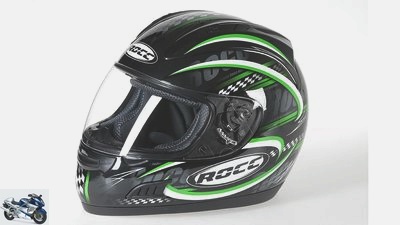
mps photo studio
26/43
Rocc 300 (model 2015)
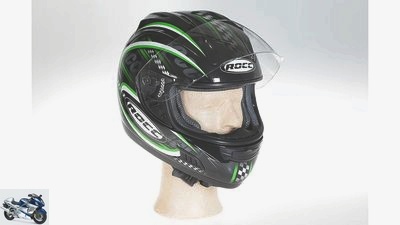
mps photo studio
27/43
Lies in the wind without any problems and only allows a moderate amount of noise to get through.
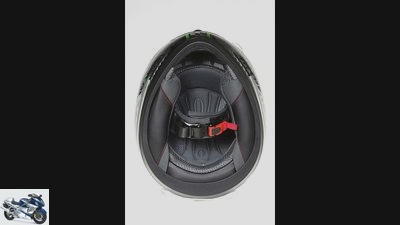
mps photo studio
28/43
A little more draft would be great.
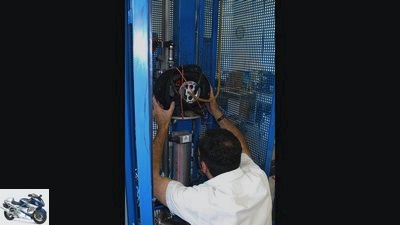
Klaus Herder
29/43
Man and machine: Peter Schaudt from TuV Rheinland places a helmet with a test head on the test bench.
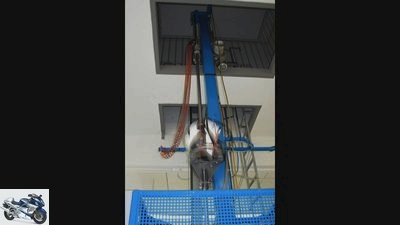
Klaus Herder
30/43
On a case-by-case basis: From a height of around three meters, it descends steeply at 7.5 m / s.
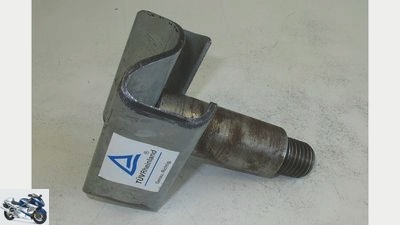
Klaus Herder
31/43
Corpus Delicti: Guard rail carrier (“Sigma post”) for the side impact.
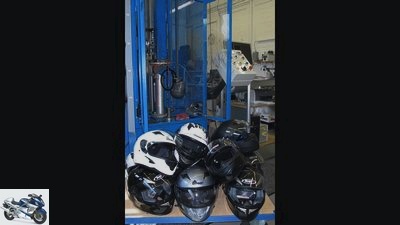
Klaus Herder
32/43
Job done: away from the HIC target value, but easily below the ECE limit.
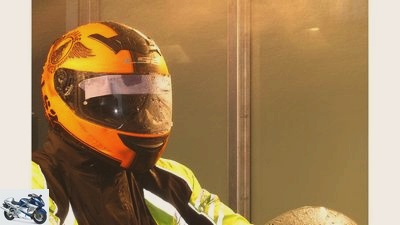
Klaus Herder
33/43
Not very tight: water ingress on the edge of the visor, recognizable by the dark discolored paper.

Klaus Herder
34/43
Climate test bench with dummy on Ducati Multistrada and rain shower at 80 km / h.
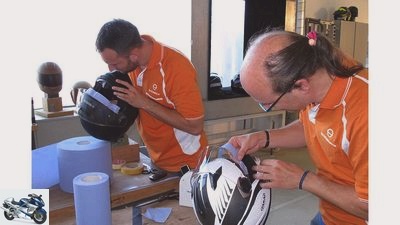
Klaus Herder
35/43
Schuberth development technician Thomas Hagemeier (left) and Sebastian Reitebuch doing the preparation.
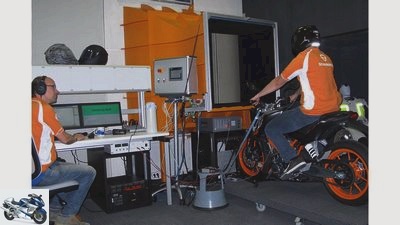
Klaus Herder
36/43
Strong on the ears: Schuberth acoustic wind tunnel with KTM 390 Duke and test headphones.

Klaus Herder
37/43
Legendary “dry test” in the MOTORRAD conference room…
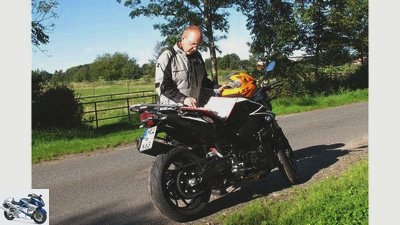
mps photo studio
38/43
…and taking the minutes after an extensive test drive with a BMW F 800 R in the north.

39/43
Impact absorption values of the cheap helmets tested.
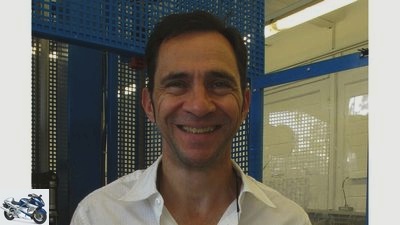
Klaus Herder
40/43
Peter Schaudt (52), helmet specialist for ECE tests on the subject of ECE approval procedures.
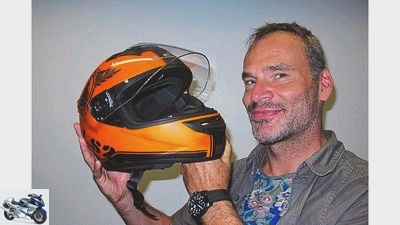
Klaus Herder
41/43
For Markus Biebricher (53), the LS2 FF352 Rookie is in first place.
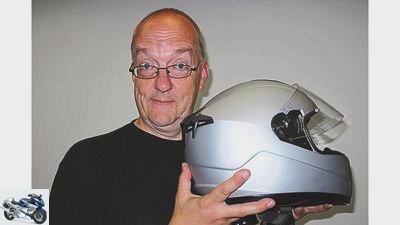
Klaus Herder
42/43
Klaus Herder (54) likes the Bayard SP-51 best.
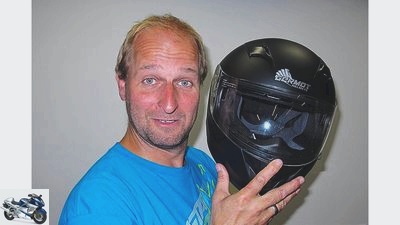
Klaus Herder
43/43
The Germot GM 306 made it to first place with Jorg Lohse (46).
clothing
Helmets
Full-face helmets up to 100 euros in a comparison test
6 inexpensive full-face helmets in the test
Bargain or Risk?
“Oh my God!” This could be the reaction of seasoned motorcyclists when they are confronted with helmets that cost less than 100 euros for the first time. Bargain or Risk? We found that out by testing six affordable full-face helmets.
Klaus Herder
09/28/2016
Dear bargain hunters and ultra perfume fans, you have to be very brave now, because at this point we are anticipating the conclusion of this test and get to the point: The big difference between “really cheap” and “really expensive” is almost always the one for helmets Difference between “works and fits somehow” and “works and fits almost perfectly”. Whether you arrive at your destination with watery eyes and booming ears after an hour or even two hours of dedicated country road or motorway boom on the super sports car is not only, but also a question of the right helmet. What the commuter, who torments himself through urban rush hour traffic for half an hour in the mornings and evenings, is just as uninteresting as the permanently clumsy schoolchildren whose 125cc has never seen more than 110 km / h and who has to decide between A used helmet from the big brother or cheaper new goods and which never needs more than 15 minutes to go to school or girlfriend. In other words: There is a – not so small – market for very affordable full-face helmets. And rightly so.
Buy complete article

6 inexpensive full-face helmets in the test
Bargain or Risk?
8 pages) as PDF
€ 2.00
Buy now
Bayard SP-51

mps photo studio
Good news when it comes to visor: locking, sealing, field of vision and changing are all right. The chin strap, however, sits very far back.
providers: Motoport, Tel. 0 44 56/89 95 71 00, www.motoport.de;
price: 89.00 euros; Sizes: S to XL;
Weight: 1450 ± 50 g / 1420 g (manufacturer information / XL weighed);
To dye: Matte black, matte silver;
Helmet shell: Polycarbonate;
Clasp: Ratchet;
Country of Manufacture: China, ECE test mark E 1 (Germany);
Replacement visors: clear / tinted, 24.95 / 24.95 euros;
Furnishing: Breathing air deflector, wind deflector on the chin, pinlock preparation, helmet bag
plus: Satisfactory easy putting on and taking off; satisfactory to good suitability for glasses; easy change of visor, good locking, practical ventilation position, large field of vision, absolutely draft-free even at high speeds; aerodynamically inconspicuous, well balanced; relatively low noise level in comparison; relatively comfortable lining; satisfactory fit, relatively clearly defined fit; Leak test passed
minus: Chinstrap hinged too far back, may press on the larynx, chinstrap pad too short; Chin part quite short, chin may bump; Ventilation slide easy to use, but practically without function; evaporates heavily when new
Conclusion: A consistently solid performance. the Bayard SP-51 also fulfills somewhat higher demands and does not show any nakedness even with prolonged highway boom. Good shock absorption values and decent workmanship round off the matter. Long nose, prominent chin? Rather not!
MOTORRAD verdict: Good
Germot GM 306
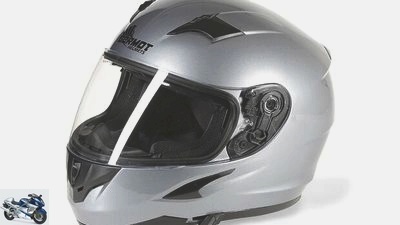
mps photo studio
A perfectly dimensioned and easy-to-use sun visor is the exception in this price range. Not plush lining.
providers: Germot, Tel. 0 61 03/45 91 00, www.germot.de;
price: 99.90 euros (multi-colored 119.90 euros);
Sizes: XS to XXL;
Weight: 1500 ± 50 g / 1530 g (manufacturer information / XL weighed);
To dye: Black, matte black, white, anthracite, six multicolored;
Helmet shell: ABS / polycarbonate mix;
Clasp: Ratchet;
Country of Manufacture: Pakistan, ECE test mark E 13 (Luxembourg);
Replacement visors: clear / tinted / mirrored, 19.90 / 19.90 / 24.90 euros;
Furnishing: Breathing air deflector, wind deflector on the chin, sun visor, helmet bag
plus: Very easy to put on and take off; Chin strap well articulated and adequately padded; good suitability for glasses; easy visor change, absolutely draft-free even at high speeds; Sun visor is very easy to use and has practical dimensions (but possibly slight distortion at the lower edge); aerodynamically inconspicuous; in comparison still sufficiently low noise level; still satisfactory fit
minus: Visor locking very coarse, relatively high operating forces, ventilation position too far; Lining a little too fluffy and chemical; Ventilation slide a bit fiddly to use and practically without function; evaporates heavily when new; slight water ingress on the visor after one minute
Conclusion: The sun visor does it. Anyone who would like to have glare protection on board in this price range will hardly find anything better. And the rest of the Germot GM 306 makes an astonishingly adult impression. With a little fine-tuning (visor, shock absorption) a “good” would be feasible.
MOTORRAD verdict: satisfying
LS2 FF352 rookie
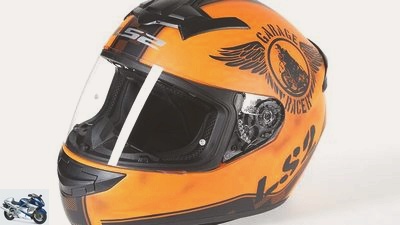
mps photo studio
Looks chic and is comparatively comfortable to wear. Is it a bit more “airy” due to the missing wind deflector on the chin.
providers: LS2 Germany, Tel. 0 44 51/9 60 29 80, www.ls2helmets.com;
price: 89.90 euros (decor 99.90 euros);
Sizes: XXS to XXL;
Weight: 1350 ± 50 g / 1390 g (manufacturer information / XL weighed);
To dye: Black, matt black, white, six decors in nine color combinations;
Helmet shell: Thermoplastic (HPTT);
Clasp: Ratchet;
Country of Manufacture: China, ECE test mark E 9 (Spain);
Replacement visors: clear / tinted / mirrored, 22.50 / 24.50 / 26.50 euros;
Furnishing: Air deflector, pinlock preparation, helmet bag
plus: Easy to put on and take off; good to very good suitability for glasses; good visor locking, practical ventilation position; aerodynamically inconspicuous; in comparison still sufficiently low noise level; satisfactory to good fit; comfortable lining; high quality decor
minus: Chinstrap hinged too far back, may press on the larynx, chinstrap pad too short; upper visor position too low, lower edge of the visor always in the field of vision, visor not completely sealed, somewhat drafty at higher speeds, somewhat fiddly visor change Ventilation slide easy to use, but practically without function; massive water ingress on the visor after 15 seconds
Conclusion: The big picture fits perfectly, but a few annoying details (e.g. chin strap attachment, visor seal) prevent an even better placement. In terms of fit, the chic LS2 FF352 Rookie belongs to the top group, and there is nothing to complain about when it comes to shock absorption.
MOTORRAD verdict: satisfying
MTR S-5
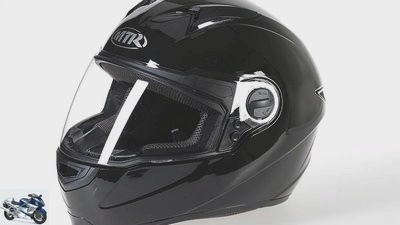
mps photo studio
Chin strap lock and visor change are – well – a bit “old-fashioned”. And the fit is not one of the great strengths either.
providers: Louis, Tel. 0 40/73 41 93 60, www.louis.de;
price: 49.99 euros (matt black 59.99 euros, multi-colored 69.99 euros);
Sizes: XS to XL;
Weight: 1480 ± 50 g / 1456 g (manufacturer information / XL weighed);
To dye: Black, matte black, three multicolor;
Helmet shell: Thermoplastic;
Clasp: Mortise lock;
Country of Manufacture: Vietnam, ECE test mark E 13 (Luxembourg);
Replacement visors: clear / tinted, 19.99 / 24.99 euros;
Furnishing: Air deflector, helmet bag
plus: Very easy to put on and take off; good to very good suitability for glasses; Price; satisfactory shock absorption values
minus: Out of date, fiddly to adjust plug lock, chin strap hinged a little too far back, can possibly press on the larynx, upholstery too short; hardly defined visor locking, ventilation position much too high, drafty, fiddly visor change; aerodynamic weaknesses, moves a little from 100 km / h (due to poor fit), strong from 120 km / h; very high noise level from 80 km / h, from 120 km / h hardly mobile without hearing protection; unsatisfactory fit, no clearly defined seat, sits much too high; Ventilation slide somewhat difficult to grip and practically without function; minimal water ingress on the visor after 1.5 minutes
Conclusion: Clear direction – with this very cheap cheap home, the Lidl and Aldi special offers are to be offered paroli. Can work, provided you are a passionate moped scooter driver with a very individual head shape. Otherwise it won’t be easy.
MOTORRAD verdict: sufficient
Shiro SH-715
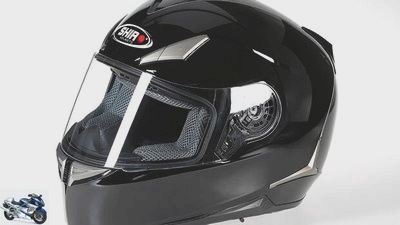
mps photo studio
A significantly deeper sun visor would have been nice. The chin strap fits nicely, but the lining is too scratchy for that.
providers: Shiro, Tel. 00 34/9 68/58 51 71 (Spain), www.shirohelmet.com;
price: 99.00 euros;
Sizes: XS to XXL;
Weight: 1390 g / 1676 g (manufacturer information / XL weighed);
To dye: Black, white, neon yellow;
Helmet shell: SECTION;
Clasp: Ratchet;
Country of Manufacture: China, ECE test mark E 9 (Spain);
Replacement visors: clear / tinted / mirrored, 22.00 / 26.00 / 30.00 euros;
Furnishing: Breathing air deflector, wind deflector on the chin, sun visor, helmet bag
plus: Relatively easy to put on and take off; chin strap articulated in a practical manner; easy change of visor; aerodynamically largely inconspicuous (but you can clearly feel the heavy weight when looking sideways); Sun visor operation is relatively easy with a little getting used to
minus: Only moderate suitability for glasses (threading the temples fiddly); Chinstrap pad too short; very coarse visor notch, ventilation position too far; Sun visor too short; relatively high noise level; scratchy lining, fit quite inhomogeneous, no clearly defined seat; Ventilation slide somewhat difficult to grip and practically without function; very heavy and not optimally balanced; minimal water ingress on the visor after two minutes
Conclusion: There is no nakedness on the shock absorption test bench – only none of the other test participants do either. And then it becomes difficult if you can’t even begin to shine in any of the test points. Many small and medium-sized quirks bring the penultimate place.
MOTORRAD verdict: satisfying
Takai Atlas
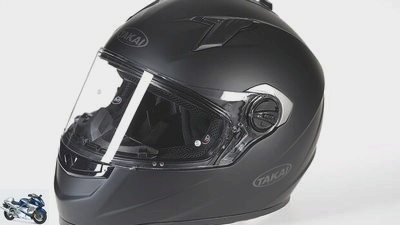
mps photo studio
The sun visor is absolutely practical, and the fit is also okay. Almost a € 200 helmet to the touch.
providers: Hein Gericke, Tel. 02 11/9 89 88 88, www.hein-gericke.de;
price: 79.95 euros (decor 99.95 euros);
Sizes: XS to XL;
Weight: 1500 ± 50 g / 1554 g (manufacturer information / XL weighed);
To dye: Matt black, three decors;
Helmet shell: Polycarbonate;
Clasp: Ratchet;
Country of Manufacture: China, ECE test mark E 9 (Spain);
Replacement visors: clear / mirrored, 34.90 / 39.90 euros;
Furnishing: Breathing air deflector, wind deflector on the chin, sun visor, pinlock preparation, helmet bag
plus: Relatively easy to put on and take off; good chin strap padding; good suitability for glasses; coarse but clearly defined visor detent, relatively easy visor change; Sun visor is easy to use and has practical dimensions; aerodynamically inconspicuous; in comparison still sufficiently low noise level; satisfactory to good fit; comfortable lining; comparatively lavish equipment and quality design
minus: Chin strap hinged a little too far back, can possibly press on the larynx; Visor ventilation position too far; Visor not completely sealed, a bit drafty at higher speeds; Ventilation slide easy to use, but practically without function; Moderate water ingress on the visor after 45 seconds
Conclusion: The Gericke house-brand product comes from the same factory as the LS2, and you can definitely tell that it was not a small China-Klitsche, but a modern company that developed and produced it. The visor could do with a little facelift.
MOTORRAD verdict: satisfying
| Full face helmets tested | valuation | Purchase opportunity |
| Bayard SP-51 | Good | Order now on eBay |
| Germot GM 306 | satisfying | Order now from Amazon |
| LS2 FF352 rookie | satisfying | Order now from Amazon |
| Shiro SH-715 | satisfying | In specialist shops |
| Takai Atlas | satisfying | In specialist shops |
| MTR S-5 | sufficient | Order now at Louis.de |
| Hero katana | without rating | Order now from Amazon |
| Nexo Basic | without rating | In specialist shops |
| Rocc 300 (model 2015) | without rating | Order now from Amazon |
Three other models under 100 euros without a test rating
When it comes to the procurement of test samples for helmets, MOTORRAD has tried out pretty much all the options over the past three decades. First option: purchase in stores. Has the advantage of the greatest possible non-manipulability. Serious disadvantage: You can bet that if the test result is worse than “good”, the manufacturer will swear that the model has been improved in the meantime (of course unnoticed and not externally recognizable) or that the test sample was guaranteed to be incorrectly stored in stores . Prove the opposite. Hence the second procurement option: MOTORRAD draws the test samples from a certain lot size directly in the warehouse. Advantage: You have to go to a lot of effort and use criminal energy to manipulate the entire lot size inventory. Disadvantage: That’s exactly what has already been done.
So to the third, currently valid procurement method: extremely short-term (maximum ten to 14 days in advance) request from the manufacturer or importer, which severely restricts the possibilities of manipulation and ensures that the goods are guaranteed to be up-to-date. In addition, the helmets are subjected to a detailed test at TuV Rheinland and, if there is the slightest doubt about the standard condition, compared with copies bought in stores. Number of manipulation attempts identified so far: Zero, the market controls itself. Disadvantage of this procedure: Only those who want to be there are included in the test. Which is usually not a problem because everyone almost always wants it. It was a different story for helmets under 100 euros, however, because a lot of them – for whatever reason – preferred not to appear in this story. But then it should be a few more models, and so MOTORRAD went shopping and got three more models. They are presented here out of competition and do not get a test result.
Hero katana
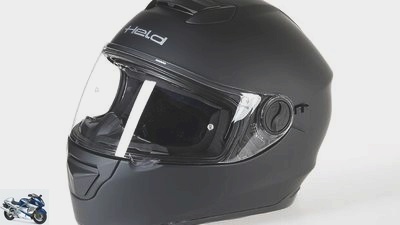
mps photo studio
Heavyweight with a practical and easy-to-use sun visor and a relatively low noise level.
providers: Held, Tel. 0 83 21/6 64 60, www.held.de;
price: 99.95 euros (decor 109.95 euros), bought online at FC-Moto for 99.90 euros;
Sizes: XS to XXL;
Weight: 1550 ± 50 g / 1618 g (manufacturer information / XL weighed);
To dye: Black, six decors;
Helmet shell: SECTION;
Clasp: Ratchet;
Country of Manufacture: China, ECE test mark E 13 (Luxembourg);
Replacement visors: clear / tinted / mirrored, 17.95 / 17.95 / 17.95 euros;
Furnishing: Breathing air deflector, wind deflector on the chin, sun visor, helmet bag
Conclusion: No surprise with the Chinese helmet bought from the Allgau glove experts and motorcycle outfitters – neither positive nor negative. The fit and aerodynamic quality are in the lower U-100 euro range.
Nexo Basic

mps photo studio
An absolutely draft-free visor is the great Nexo strength, the sweaty lining and the too spongy padding are not.
providers: Polo, Tel. 0 21 65/8 44 04 00, www.polo-motorrad.com;
price: 59.95 euros, bought online at Polo for 49.95 euros;
Sizes: XS to XL;
Weight: 1500 ± 50 g / 1534 g (manufacturer information / XL weighed);
To dye: Black, matte black;
Helmet shell: Thermoplastic;
Clasp: Ratchet;
Country of Manufacture: China, ECE test mark E 9 (Spain);
Replacement visors: clear / tinted / mirrored, 24.99 / 29.99 euros;
Furnishing: Breathing air deflector, wind deflector on the chin, helmet bag
Conclusion: In terms of shock absorption, the very affordable Polo house-brand product would have been way ahead in a test, but it would have missed a lot of points in terms of aerodynamics and above all in terms of fit.
Rocc 300 (model 2015)
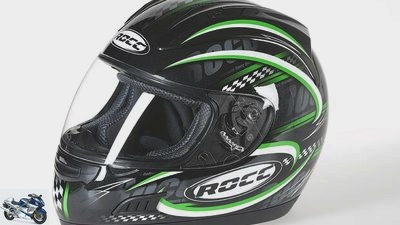
mps photo studio
Lies in the wind without any problems and only lets through a moderate amount of noise. A little more draft would be great.
providers: Buse, Tel. 0 24 71/1 26 90, www.buese.com;
price: 89.95 euros (decor 99.95 euros), bought online at FC-Moto for 89.90 euros;
Sizes: XS to XL (matt black to XXL);
Weight: 1500 ± 50 g / 1576 g (manufacturer information / XL weighed);
To dye: Black, matt black, neon yellow, six decors;
Helmet shell: SECTION;
Clasp: Ratchet;
Country of Manufacture: China, ECE test mark E 1 (Germany);
Replacement visors: clear / tinted / mirrored, 21.95 / 21.95 / 29.95 euros;
Furnishing: Air deflector, helmet bag
Conclusion: Buse’s own brand product makes a pleasantly valuable impression on first contact, but in practice it is also not magic. The fit is quite okay, but show some weaknesses in detail: U-100-Euro-Liga.
The helmets on the TuV test bench
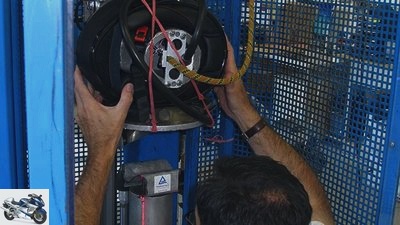
Klaus Herder
Man and machine: Peter Schaudt from TuV Rheinland places a helmet with a test head on the test bench.
The successfully completed examination according to the helmet test standard ECE R 22.05 is a basic requirement for making it into the selection for the MOTORCYCLE helmet test. However, the editors consider the mundane re-measurement of the ECE shock absorption values to be superfluous. On the one hand, this is due to the fact that the helmet manufacturers observe themselves closely. Peter Schaudt, helmet expert at TuV Rheinland: “As soon as a provider with new models appears on the market, we receive them from competitors to check the ECE values.” On the other hand, in the opinion of MOTORRAD, the ECE only sets a minimum requirement for motorcycle helmets Are defined. On the one hand, this is due to the sometimes absurd test specifications, in which the drop tests are carried out with helmets frozen to minus 20 degrees. In addition, the points of impact are precisely defined in the European standard. Which in turn encourages some helmet providers to reinforce the test points accordingly. A procedure that is within the legal framework, but which makes critics scoff at the fact that this method can even be used to knit a bobble hat so it is ECE-compliant. For this reason, MOTORRAD sat down at the table with TuV expert Schaudt and accident researcher and biomechanic Florian Schueler as early as 2009 to develop a practical test procedure for helmets.
For seven years now, the “MOTORCYCLE helmet standard” has proven itself in numerous comparative tests. Central point: the helmet continues to fall from a height of around three meters on the test stand of TuV Rheinland, but not on the ECE edge anvil, but on a real guardrail support (“Sigma post”), which, according to Florian Schueler, is often tragic in accidents Role. The helmets are also tested at room temperature; the impact on the left and right side occurs at both low and high speeds. According to ECE, an acceleration value of 275 g is permissible in the event of an impact on the test anvil. The probe equipped with sensors forwards the g-value to a computer, which calculates the HIC-value with the help of other parameters (duration of force application). The “Head Injury Criterion” is considered by doctors and biomechanics as an informative value for making statements about possible brain / skull injuries. The ECE allows a maximum HIC value of 2400. An abstract number, but above all far beyond good and bad. The MOTORRAD expert crew agrees: “In the MOTORRAD test, HIC 1000 should be feasible!” The tested candidates are still a long way from achieving this desired value, but at least they easily meet the ECE minimum requirements and are thus on par with some helmets Middle and upper class.
This is how MOTORRAD tests
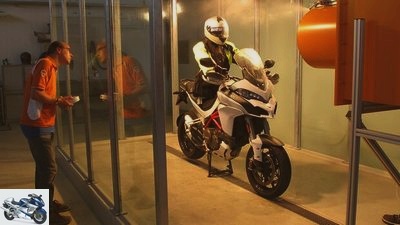
Klaus Herder
Climate test bench with dummy on Ducati Multistrada and rain shower at 80 km / h.
Five copies of each helmet model were put to the test: three in size M, one each in size L and XL. Two specimens in M did not survive the helmet test because they were destroyed as part of the shock absorption test at TuV Rheinland in Cologne (see picture gallery). The three remaining test samples each had to show what they can do in practical trials. A BMW F 800 R was used for the big comparison lap. This time in the far north of Germany and not on the A 81 motorway between Heilbronn and Wurzburg, which is otherwise popular for helmet test drives. The background to the change of location: The proportion of urban and rural roads was significantly higher this time than in previous helmet tests, because the typical buyer of a U-100-euro helmet is usually not a highway-kilometer eater. And that’s exactly why the speed limit this time was not beyond 200 km / h, but at 160 km / h. After each test lap, the driving impressions that were still fresh were recorded. In order to be able to classify this a little better later, the legendary “conference room dry test” in the Stuttgart MOTORRAD editorial team was on the program at the end of the test program, in which additional colleagues who were “unencumbered” by driving impressions were involved. Once again, it was all about handling, fit and workmanship. And, as always, the editors’ totally subjective hit lists were created (see below), which once again prove that the best helmet is the one that fits and pleases you personally.
Ironically, when testing the cheapest helmets in recent MOTORRAD helmet test history, the editors made a lot of extra effort. Which was due to a certain coincidence, because just at the time of the scheduled test drives, the German helmet manufacturer Schuberth invited to the advance presentation of its INTERMOT innovations C4 (sporty flip-up helmet) and R2 (puristic full-face helmet without sun visor) at the factory in Magdeburg. There is not only production, but also diligent development. Among other things in the “Air & Acoustic Lab ”, an (acoustic) wind tunnel, and in the climate test bench, in which, among other things, the heaviest downpours can be simulated. So what could be more obvious than planning an additional test day after the official celebrations? Even. And so it went with the test helmets in the state capital of Saxony-Anhalt. Which shouldn’t be a problem under competition law and compliance reasons, because Schuberth was not a test participant this time and, as a provider of rather high-priced premium helmets, has no economic interest in the U-100 Euro League. Concerned about supposed competitors? Not really, you move too much in completely different worlds.
Wind tunnel tests confirm practical experience
And so it happened that a MOTORRAD editor who was involved in the test drives that had been carried out immediately before received strong support from two Schuberth engineers and all helmets had to show in the wind tunnel at 100 km / h how much noise they let through to the driver’s ear. Objective test values and subjective impressions of the wind tunnel test persons coincided almost 100 percent with the results from the MOTORRAD driving tests. A great confirmation of the practical relevance of the test program – mutually.
The aim of the climate test bench was to depict a situation that cannot be reproduced in the wild: heavy rain at 80 km / h, always the same speed, always the same amount of water. The judgment of real test persons was not asked, a dummy had to expose itself to the hardships. It was necessary to survive dry for three minutes. If water penetrated through the visor and / or ventilation channels beforehand, the experiment was terminated. Indicator for leaks: workshop cleaning paper that is lovingly placed under the upper helmet opening and attracts water like a magnet. The results of the leak test were included in the awarding of points for the processing quality and can be read in the data boxes under plus / minus.
Interview with TuV test engineer Peter Schaudt

Klaus Herder
Peter Schaudt, test engineer at TuV Rheinland in Cologne.
Peter Schaudt (52), has been a test engineer at TuV Rheinland in Cologne since 1992 and has been responsible for ECE approval procedures as a helmet specialist in the motorcycle sector since 1997, among other things as a helmet specialist.
MOTORCYCLE: How many helmets do you break each year as part of the ECE test??
Peter Schaudt: So 3500 to 4000 pieces come together.
MOTORCYCLE: How many helmets are required for an ECE test??
Peter Schaudt: If the helmet manufacturer has its own test bench – this is now the rule – the helmets are pre-tested and the manufacturer knows what he is sending us. Then we need two to three pieces for each test head, making an average of 20 helmets for a basic license with a size range from XS to XXL. If the check is successful, the approval is granted but is not yet effective. For this we need 60 helmets from actual production. We check it again, and if everything goes well, the approval is effective and the manufacturer can sell.
MOTORCYCLE: How is ongoing production monitored?
Peter Schaudt: After every 3200 helmets produced, the manufacturer has to take five copies and send them to us. If the report is positive, he can build another 3200 helmets – and that goes on practically forever.
MOTORCYCLE: How expensive is the ECE test for the helmet manufacturer? And how long does it take?
Peter Schaudt: The complete test, including a major production test of the 60 copies mentioned, ideally (no follow-up or follow-up tests, etc.) costs around 5100 euros. In addition, there are the approval fees of the respective authorities of 500 to 800 euros, making a total of around 6000 euros. And if everything works out without any problems, approval can be granted after two weeks.
Hit list of the editors
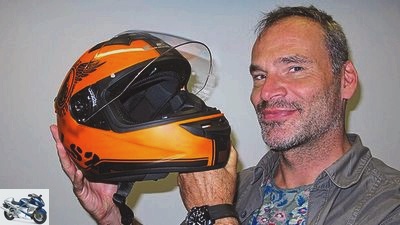
Klaus Herder
For Markus Biebricher (53), the LS2 FF352 Rookie is in first place.
Markus Biebricher (53)
MOTORRAD reference model for fit issues in the nose and chin area; is very sensitive to chin strap misplacement.
1. LS2 FF352 rookie
2. Takai Atlas
6. MTR S-5
Klaus Herder (54)
MOTORCYCLE expert for long-distance equipment suitable for the elderly; hates acoustic and aerodynamic inadequacies.
1. Bayard SP-51
2. Germot GM 306
6. MTR S-5
Jorg Lohse (46)
MOTORRAD standard head in terms of lining materials and visor operation; mistrusts helmets without a practical ventilation position.
1. Germot GM 306
2. Takai Atlas
6. Shiro SH-715
MOTORCYCLE final scoring
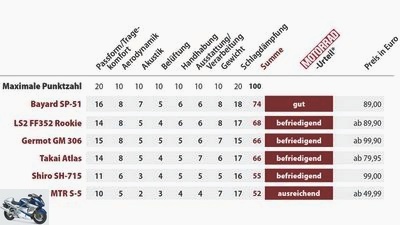
* 100 to 85 points = very good; 84 to 70 points = good; 69 to 55 points = satisfactory; 54 to 40 points = sufficient; 39 to 0 points = unsatisfactory
More than was to be expected: After all, a cheap man from home made the test rating “good”, and three of the “satisfactory” helmets could have passed the 200 Euro league a few years ago. Most important finding: All test candidates provide solid basic protection. With active safety, however, (much) more is possible.
* 100 to 85 points = very good; 84 to 70 points = good; 69 to 55 points = satisfactory; 54 to 40 points = sufficient; 39 to 0 points = unsatisfactory
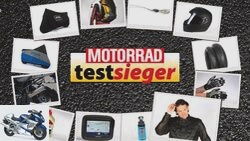
clothing
The best motorcycle clothing
Motorcycle clothing – tests at a glance
read more
Why can they be so cheap at all?
A properly fitting new helmet for 80 euros is in any case the better choice than the still fancy, but unfortunately somewhat too large, used hat from the family’s heritage, which cost ten times as much a dozen years ago. Anyone who drives a lot, who drives fast and who attaches great importance to wearing comfort, low weight or just functioning ventilation, can usually not avoid buying a significantly higher-priced full-face helmet. But back to our cheap homes: Why can they be so cheap at all? That of course starts with the country of origin. None of the price breakers come from Germany, Italy, Korea or Japan; China is almost always the cheap country of choice. And there are very many injection molding machines in very large factories in which helmet shells are manufactured. These helmet shells, so-called thermoplastics (for example ABS or polycarbonate), are very inexpensive to produce because their manufacture is largely automated and their production time is very short, which in turn allows high quantities.
The granulate liquefied in the injection molding machines is very cheap, and the only thing that costs a lot of money in the production of thermoplastics is the injection mold. But this is a one-time purchase that pays for itself very quickly over the number of pieces. The distribution channels of these very cheaply produced helmets are also usually significantly shorter than those of the relevant brand suppliers. The full-face helmets are usually sold under the label of the house or own brands of the major motorcyclist outfitters and end up directly in the German central warehouse from the factory. There is no intermediate trade, which means that around 30 percent surcharge on the purchase price is no longer necessary. In addition to the cheap production and direct purchasing, it is above all the lack of development costs that keep the price low. The major accessory dealers choose a certain basic shape from the helmet manufacturers, which then only needs to be modified in details (ventilation slider, interior fittings) so that a “new” helmet is created. This modular system makes the competitive prices possible.
Test results more pleasing than expected
The lack of development and detailed work is also to blame for the fact that, for example, none of the helmets tested have functioning and, above all, controllable ventilation. Why this is so became clear, among other things, during the water tightness test in the Schuberth climate test bench (see picture gallery): on the one hand, only a few visors sealed 100 percent, on the other hand, not a single drop of water penetrated through any ventilation. Simple explanation for the supposedly good dryness on the top of the head: In no full-face helmet are the holes in the helmet shell and the holes in the shock-absorbing EPS dome aligned – and where nothing is aligned, nothing gets through – for example, cooling air.
The bottom line is that this year’s test results were much more gratifying than those of eight or nine years ago, when MOTORRAD last focused on the low-price segment. The fact that trying out is more important than studying a test report applies to all helmets, but especially to the particularly inexpensive ones. The probability of finding the proverbial “sneaker” is significantly lower than in the helmet Champions League, but there is hope.
Related articles
-
Full-face helmets up to 250 euros in the 2017 test
Photos: mps-Studio 10 pictures mps studio 1/10 10th place: IXS HX 444, from 199.95 euros, 59/100 points, MOTORRAD judgment “satisfying” mps studio 2/10…
-
Flip-up motorcycle helmets between 139 and 649 euros in the test
Photo: mps-Studio 12th pictures mps studio 1/12 12th place: LZR MH2, from 139 euros, 52/100 points, MOTORRAD judgment “sufficient” mps studio 2/12 9th…
-
Product test: full-face helmets for 200 euros
Bilski 17th pictures Bilski 1/17 The chin part of the Scorpion EXO-750 stands out because it can be perfectly adapted to the chin with an air pump and…
-
Motorcycle helmets for the racetrack in a comparison test
PHOTO-BK.COM 23 pictures PHOTO-BK.COM 1/23 In the comparison test, eleven racing helmets faced each other. mps photo studio 2/23 Simple but very…
-
16 flip-up motorcycle helmets in a comparison test
2snap 57 pictures mps photo studio 1/57 Rather unusual: the chin section can be swiveled backwards, … mps photo studio 2/57 The opener on the chin part…
-
Product test sporty full-face helmets
2snap clothing Helmets Product test sporty full-face helmets Product test sporty full-face helmets Helmets for the racetrack How do the motorcycle…
-
Product test: top-class sports helmets in comparison
2snap clothing Helmets Product test: top-class sports helmets in comparison Comparative test sports helmets of the upper class Well protected with the…
-
Test winner mid-range full-face helmets (MOTORRAD 6-2013)
mps studio clothing Helmets Test winner mid-range full-face helmets (MOTORRAD 6/2013) Test winner mid-range full-face helmets (MOTORRAD 6/2013) Nexx…
-
Test winner full-face helmets with sun visor (MOTORRAD 6-2014)
mps studio clothing Helmets Test winner full-face helmets with sun visor (MOTORRAD 6/2014) Test winner full-face helmets with sun visor (MOTORRAD 6/2014)…
-
14 sporty full-face motorcycle helmets in a comparison test
Klaus Herder 50 pictures Klaus Herder 1/50 mps photo studio 2/50 Visor without detent and with locking in the field of vision. mps photo studio 3/50…